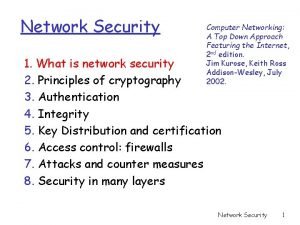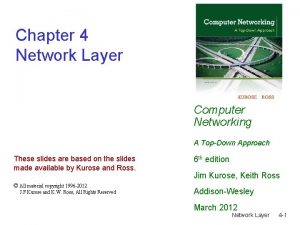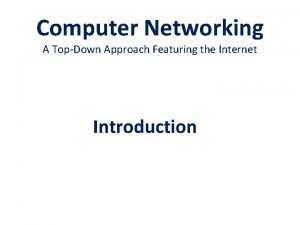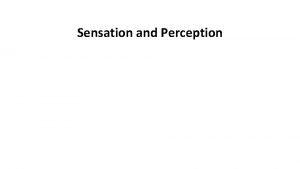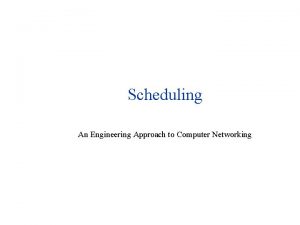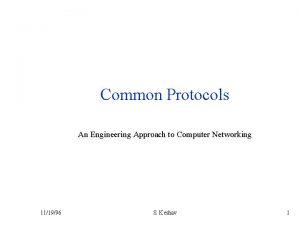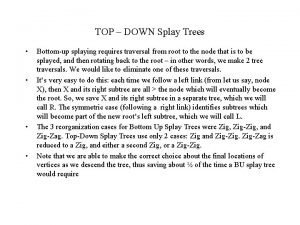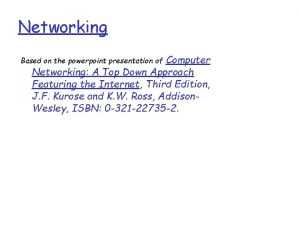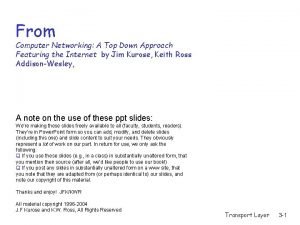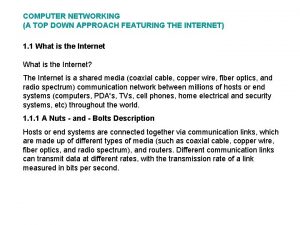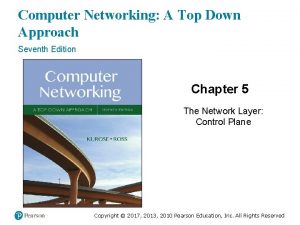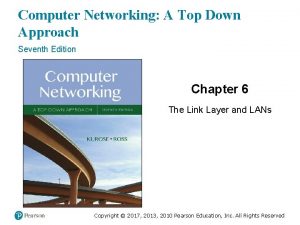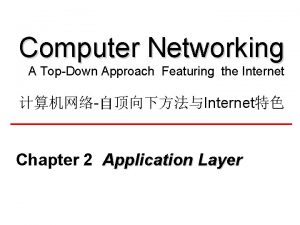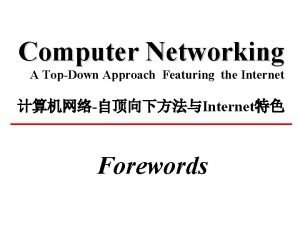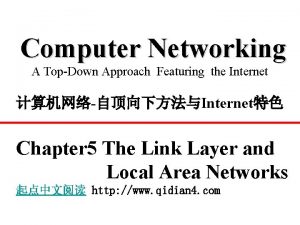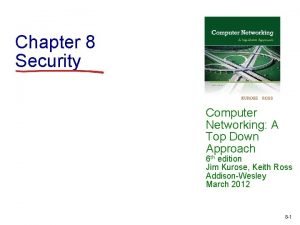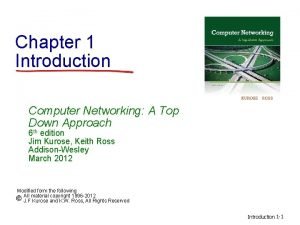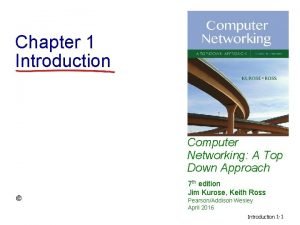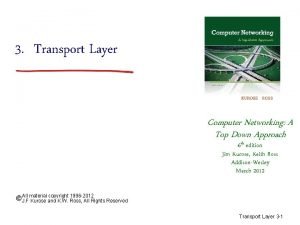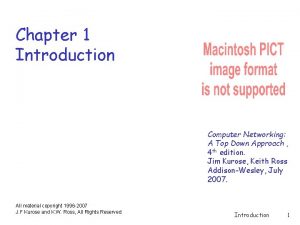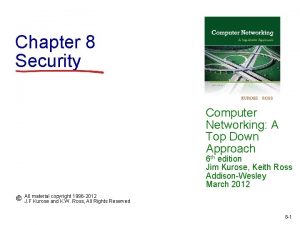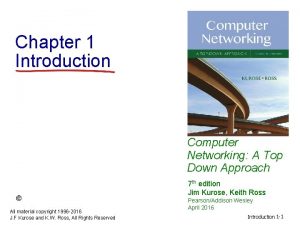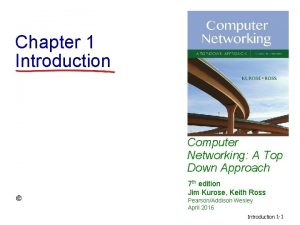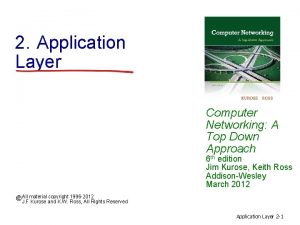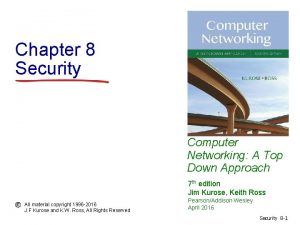Networking Computer Networking A Top Down Approach Featuring

























- Slides: 25

Networking Computer Networking: A Top Down Approach Featuring the Internet, Third Edition, J. F. Kurose and K. W. Ross, Addison. Wesley, ISBN: 0 -321 -22735 -2. Based on the powerpoint presentation of

Internet structure: network of networks q roughly hierarchical q at center: “tier-1” ISPs (e. g. , UUNet, BBN/Genuity, Sprint, AT&T), national/international coverage m treat each other as equals Tier-1 providers interconnect (peer) privately Tier 1 ISP

Tier-1 ISP: e. g. , Sprint US backbone network

Internet structure: network of networks q “Tier-2” ISPs: smaller (often regional) ISPs m Connect to one or more tier-1 ISPs, possibly other tier-2 ISPs Tier-2 ISP pays tier-1 ISP for connectivity to rest of Internet q tier-2 ISP is customer of tier-1 provider Tier-2 ISP Tier 1 ISP Tier-2 ISP NAP Tier 1 ISP Tier-2 ISPs also peer privately with each other, interconnect at NAP Tier-2 ISP

Tier-2 ISP: e. g. , Abilene (Internet 2) http: //loadrunner. uits. iu. edu/weathermaps/abilene. html

Internet structure: network of networks q “Tier-3” ISPs and local ISPs m last hop (“access”) network (closest to end systems) local ISP Local and tier 3 ISPs are customers of higher tier ISPs connecting them to rest of Internet Tier 3 ISP Tier-2 ISP local ISP Tier-2 ISP Tier 1 ISP Tier-2 ISP local ISP NAP Tier 1 ISP Tier-2 ISP local ISP

Internet structure: network of networks q a packet passes through many networks! local ISP Tier 3 ISP Tier-2 ISP local ISP Tier-2 ISP Tier 1 ISP Tier-2 ISP local ISP NAP Tier 1 ISP Tier-2 ISP local ISP

How do loss and delay occur? packets queue in router buffers q packet arrival rate to link exceeds output link capacity q packets queue, wait for turn packet being transmitted (delay) A B packets queueing (delay) free (available) buffers: arriving packets dropped (loss) if no free buffers

Four sources of packet delay q 1. nodal processing: m determine output link q 2. queueing m time waiting at output link for transmission m depends on congestion level of router transmission A propagation B nodal processing queueing

Delay in packet-switched networks 3. Transmission delay: q time to send bits into link = L/R 4. Propagation delay: q time to travel down link transmission A propagation B nodal processing queueing

“Real” Internet delays and routes q What do “real” Internet delay & loss look like? q Traceroute program: provides delay measurement from source to router along end-end Internet path towards destination. For all i: m m m sends three packets that will reach router i on path towards destination router i will return packets to sender times interval between transmission and reply. 3 probes

Packet loss q queue (aka buffer) preceding link in buffer has finite capacity q when packet arrives to full queue, packet is dropped (aka lost) q lost packet may be retransmitted by previous node, by source end system, or not retransmitted at all

Protocol “Layers” Networks are complex! q many “pieces”: m hosts m routers m links of various media m applications m protocols m hardware, software Question: Is there any hope of organizing structure of network? Or at least our discussion of networks?

Organization of air travel ticket (purchase) ticket (complain) baggage (check) baggage (claim) gates (load) gates (unload) runway takeoff runway landing airplane routing q a series of steps

Organization of air travel: a different view ticket (purchase) ticket (complain) baggage (check) baggage (claim) gates (load) gates (unload) runway takeoff runway landing airplane routing Layers: each layer implements a service m via its own internal-layer actions m relying on services provided by layer below

Layered air travel: services Counter-to-counter delivery of person+bags baggage-claim-to-baggage-claim delivery people transfer: loading gate to arrival gate runway-to-runway delivery of plane airplane routing from source to destination

ticket (purchase) ticket (complain) baggage (check) baggage (claim) gates (load) gates (unload) runway takeoff runway landing airplane routing intermediate air traffic sites airplane routing arriving airport Departing airport Distributed implementation of layer functionality

Why layering? Dealing with complex systems: q explicit structure allows identification, relationship of complex system’s pieces q modularization eases maintenance, updating of system

Internet protocol stack q application: supporting network applications m HTTP, FTP, SMTP application q transport: host-host data transfer m TCP, UDP transport q network: routing of datagrams from network source to destination m IP, routing protocols q link: data transfer between neighboring network elements m PPP, Ethernet q physical: bits “on the wire” link physical

Layering: logical communication application transport network link physical application transport network link physical

Layering: logical communication E. g. : transport q take data from q q app addressing, and other info send packet to peer wait for peer to respond analogy: post office data application transport network link physical ack data network link physical application transport network link physical data application transport network link physical

Layering: physical communication data application transport network link physical application transport network link physical data application transport network link physical

Protocol layering and data Each layer takes data from above q adds header information to create new data unit q passes new data unit to layer below source M Ht M Hn Ht M Hl Hn Ht M application transport network link physical destination application Ht transport Hn Ht network Hl Hn Ht link physical M message M segment M datagram M frame

Internet History 1980 -1990: new protocols, a proliferation of networks q 1983: deployment of q q TCP/IP 1982: SMTP e-mail protocol defined 1983: DNS defined for name-to-IP-address translation 1985: FTP protocol defined 1988: TCP congestion control q new national networks: Csnet, BITnet, NSFnet, Minitel q 100, 000 hosts connected to confederation of networks

Internet History 1990, 2000’s: commercialization, the Web, new apps q early 1990 s: Web m hypertext m HTML, HTTP: Berners- Lee m 1994: Mosaic, later Netscape m late 1990’s: commercialization of the Web Late 1990’s – 2000’s: q more killer apps: instant messaging, peer 2 peer file sharing (e. g. , Naptser) q network security to forefront q est. 50 million host, 100 million+ users q backbone links running at Gbps
 Computer network a top down approach
Computer network a top down approach Rip table
Rip table Top down networking
Top down networking Top down and bottom up approach
Top down and bottom up approach Bottom up approach reading
Bottom up approach reading Top down vs bottom up psychology
Top down vs bottom up psychology Call graph based integration
Call graph based integration Top down model in reading
Top down model in reading Top down profiling
Top down profiling Bottom-up listening activities
Bottom-up listening activities Greedy divide and conquer dynamic programming
Greedy divide and conquer dynamic programming An engineering approach to computer networking
An engineering approach to computer networking An engineering approach to computer networking
An engineering approach to computer networking Success acrostic
Success acrostic If a round analog clock featuring numbers 1-12
If a round analog clock featuring numbers 1-12 Deng xioping
Deng xioping Software defined networking vs traditional
Software defined networking vs traditional Top down control
Top down control Move the bottom up and down
Move the bottom up and down Top down processing vs bottom up processing
Top down processing vs bottom up processing Modular design programming
Modular design programming Top down splay tree
Top down splay tree Bottom up vs top down processing
Bottom up vs top down processing Tono ng kwento
Tono ng kwento Top down design coding
Top down design coding Gloria suarez
Gloria suarez
